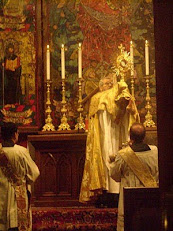November 11, 2010
by The Rt. Rev. Andrew Burnham, SSC
III. Without excluding liturgical celebrations according to the Roman Rite, the Ordinariate has the faculty to celebrate the Holy Eucharist and the other Sacraments, the Liturgy of the Hours and other liturgical celebrations according to the liturgical books proper to the Anglican tradition, which have been approved by the Holy See, so as to maintain the liturgical, spiritual and pastoral traditions of the Anglican Communion within the Catholic Church, as a precious gift nourishing the faith of the members of the Ordinariate and as a treasure to be shared. Anglicanorum cœtibus
THERE HAS BEEN much speculation as to what constitutes 'Anglican Patrimony'. It is interesting that the word 'patrimony' occurs only once in the Apostolic Constitution Anglicanorum cœtibus, and only once in the set of norms governing the constitution. In both cases the reference is to what should be part of the formation of ordinands. Anglican Patrimony, therefore, is not specifically to do with matters of liturgy, though, as we have seen from the quotation from the Constitution, maintaining 'the liturgical, spiritual and pastoral traditions of the Anglican Communion within the Catholic Church' would be 'a precious gift nourishing the faith of the members of the Ordinariate and…a treasure to be shared'. Note here that these traditions are brought to the Catholic Church but note also that they are 'a treasure to be shared', those already Catholics, including those with no Anglican previous, are also to be the beneficiaries.
Anglican Patrimony
We have already had plenty of fun with Anglican Patrimony. There was the occasion when the Principal of Pusey House met an Oratorian on Oxford Station. 'I'm waiting for my wife', said Fr Baker. 'Ah, your Anglican Patrimony', said the Oratorian. 'Don't you mean my Anglican Matrimony?' said Fr Baker. And then there was the Music List for St George-by-the-Gasworks with San Juan de Fagondez and Our Lady of Fatima, Dalston', published in New Directions in April of this year. What better for Palm Sunday Mass than Hummel, Schütz, Allegri and Gesualdo? Other examples of Anglican Patrimony in the week's Music List were a Bruckner Mass, a Cherubini motet, the Pergolesi Stabat Mater, and Duruflé's Ubi caritas. One loses count of the number of times someone has quipped 'Anglican Patrimony' in various exotic circumstances of the kind found usually only in Anglo-catholic circles, the processing of the Christmas bambino on the humeral veil, the grating noise of the rattle on Good Friday. But, as with any joke, there is always an underlying truth. Anglican Patrimony has preserved things that continental aggiornamento perhaps prematurely discarded.
Beneath the humour about the colourful customs is the huge joke that, for many, at least as far as England is concerned, Anglican Patrimony - if by that we mean Anglo-catholic Patrimony - is a rather stylish imitation of ultramontane Catholicism, in ceremonial and text. Moreover there is the slightly haughty feeling that one would be bringing back to the Latin Rite some of the things it should never have discarded and what it has ceased to do well. There is often a rather unpleasant element of social class here. Though Anglo-catholicism is justly proud of its care for the urban poor, 'Father' himself is often cultured and possessed of exquisite good taste, creating a liturgical ambience that readily evokes the beauty of holiness. He has a vestment press complete with embroidered fiddlebacks wrapped in the proper kind of acid-free tissue paper, rescued from French sacristies, where Vatican II polyester is nowadays à la mode. And insofar as Anglican Patrimony is something distinct from Anglo-catholic Patrimony, is it anything we are bothered about? Change-ringing. The flower rota. The Old English surplice. Hymns Ancient and Modern. And much beloved by John Major, George Orwell's 'old maids, bicycling to Holy Communion through the morning mist.'
Some of the most intelligent exchanges about Anglican Patrimony have been that it is not really a liturgical thing, especially amongst those who make such extensive use of the Roman Missal. Anglican Patrimony is more about a certain kind of spirituality, the subject of Fr Orford's talk today, and about a pastoral method and way of relating to communities and neighbourhoods. It is an ethos hard to define but easy to identify...
Read the rest of Bishop Burnham's explication of Anglican Patrimony at the blog of the same name, Anglican Patrimony.
My good people
-
Wise people who frequent the exquisite little Penlee Gallery in Penzance
will be familiar with one of its prize exhibits: The rain it raineth every
day (1...
4 months ago












No comments:
Post a Comment